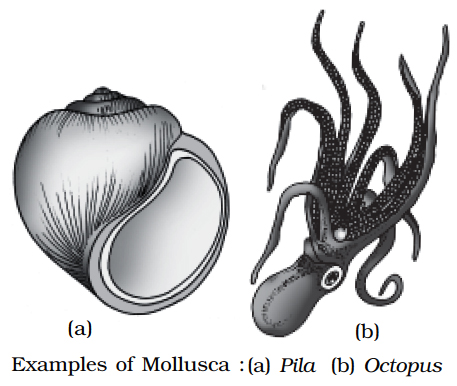- Books Name
- ACME SMART COACHING Biology Book
- Publication
- ACME SMART PUBLICATION
- Course
- CBSE Class 11
- Subject
- Biology
PHYLUM MOLLUSCA
Phylum mollusca is the second largest phylum in animal kingdom which includes over 60,000 species. General characters are :
- Molluscs are terrestrial, aquatic (fresh water or marine) triploblastic, bilaterally symmetrical, schizocoelic and unsegmented animals.
- Most molluscs secrete a shell of calcium carbonate that protects and supports their soft tissues.
- The body is organised into three general regions: head, foot and visceral hump.
- The visceral hump contains the digestive tract and other visceral organs.
- The body is covered by a soft and spongy skin fold called mantle which secretes the shell.
- The space between the hump and the mantle is called mantle cavity in which feather like gills are present.
- Molluscs typically employ a feeding organ called radula which is armed with rows of chitinous teeth. The radula is protruded from the mouth and worked back and forth to rasp the food into fine particles.
- Circulatory system is mainly of open type but some reduced sinuses are present. Respiratory pigment is haemocyanin.
- Respiration occurs by feather like gills, pulmonary sac or both, or through general body surface.
- Excretion occurs by paired Organ of Bojanus. Another excretory organ called Keber's organ (Pericardial gland) is also present in Unioalongwith paired organ of Bojanus. It pours the waste into pericardium from where the waste is carried to the organ of Bojanus that opens out through mantle cavity.
- Sense organs include eyes, statocysts and osphradia (chemoreceptor to test chemical nature of water).
- Reproduction sexual, adults can be dioecious (unisexual) or monoecious (bisexual or hermaphrodite) Fertilization is generally external, development is direct or through free larval forms like trochophore, veliger (in Pila), glochidium (in Unio) -an ectoparasite on fishes.

Pila produces 2 types of sperms :
(i) Eupyrene -Motile and functional sperms, 25 µm long, thread like with a single cilium.
(ii) Oligopyrene -Non-motile and non-functional sperms, 32.5 µm long, spindle shaped with 4-5 cilia.
CLASSIFICATION
Molluscs' classification is mainly on the basis of shell and foot.

Concept Builder
(i) Architeuthis (Giant AtJantic squid) is the largest and heaviest among invertebrates, 55 feet length.
(ii) Nautilus is the only cephalopod with external shell, so ink glands are absent.
(iii) The colour change in cephalopods occurs due to chromatophores.

 Maria Habib
Maria Habib
